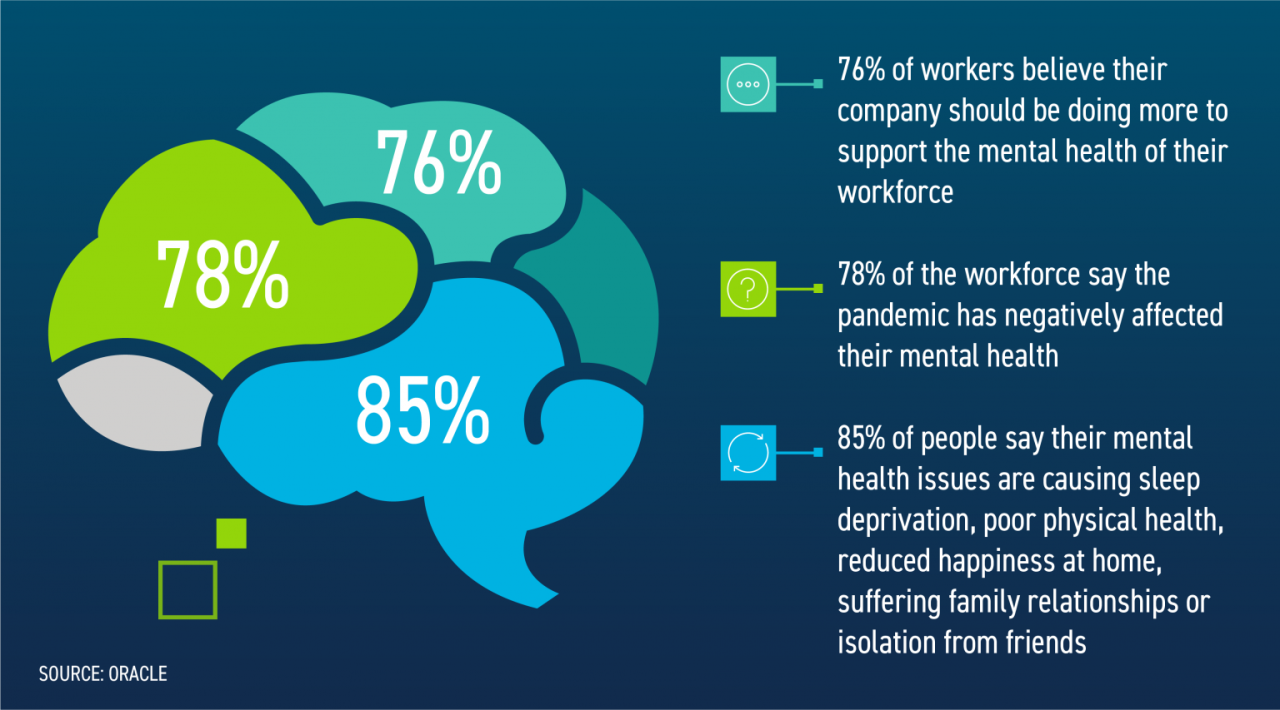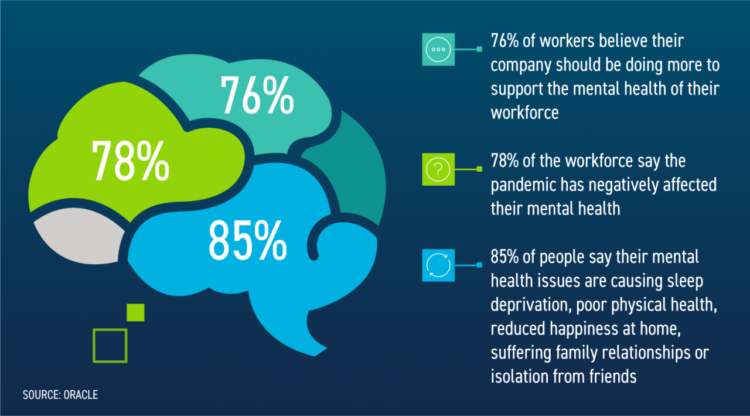
- Prevalence of Mental Health Issues in the Workplace
- Causes and Risk Factors for Workplace Mental Health Concerns
- Symptoms and Impact of Workplace Mental Health Issues
- Strategies for Promoting Workplace Mental Health
- The Role of Managers and Leaders in Workplace Mental Health
- Best Practices for Supporting Employees with Mental Health Concerns
- Legal and Ethical Considerations for Workplace Mental Health
- Future Trends and Innovations in Workplace Mental Health
Prevalence of Mental Health Issues in the Workplace
Mental health concerns are prevalent in today’s workplace, affecting a significant number of employees. Studies have shown that a substantial portion of the workforce experiences mental health challenges, ranging from mild to severe.
According to the World Health Organization (WHO), an estimated 26% of adults worldwide experience mental health disorders each year. In the United States, the National Institute of Mental Health (NIMH) reports that one in five adults experiences a mental health condition annually.
Impact on Workplace Productivity and Absenteeism
Mental health issues can significantly impact workplace productivity and absenteeism. Employees experiencing mental health challenges may face difficulties concentrating, making decisions, and interacting with colleagues.
- A study by the National Alliance on Mental Illness (NAMI) found that mental health conditions cost U.S. employers $179.3 billion annually in lost productivity.
- Another study by the WHO estimated that depression and anxiety alone cost the global economy $1 trillion annually in lost productivity.
Causes and Risk Factors for Workplace Mental Health Concerns

Workplace mental health concerns arise from a multitude of stressors and challenges inherent in the work environment. These factors can contribute to increased psychological distress and, if left unaddressed, may lead to more severe mental health issues.
One of the most common stressors in the workplace is excessive workload. When employees are consistently overloaded with tasks and responsibilities, they may experience feelings of overwhelm, anxiety, and burnout. This can be exacerbated by tight deadlines, unclear expectations, and a lack of control over one’s workload.
Work-Life Balance
Another significant factor affecting workplace mental health is work-life balance. When work demands encroach upon personal time and responsibilities, individuals may struggle to maintain a healthy equilibrium between their professional and personal lives. This can lead to stress, exhaustion, and relationship difficulties.
Interpersonal Conflicts
Interpersonal conflicts with colleagues or supervisors can also contribute to workplace mental health concerns. Unresolved conflicts, poor communication, and a lack of support can create a hostile or stressful work environment. These conflicts can lead to feelings of isolation, anxiety, and depression.
Organizational Culture
The organizational culture can also play a role in workplace mental health. A culture that values productivity over well-being, promotes a competitive and stressful environment, or lacks support for mental health can contribute to increased psychological distress among employees.
Symptoms and Impact of Workplace Mental Health Issues
Mental health issues can manifest in various ways in the workplace, affecting both individuals and the organization as a whole. Understanding the signs and symptoms of mental health concerns is crucial for promoting a supportive and healthy work environment.
Individual Impact
- Emotional Distress: Persistent feelings of anxiety, depression, or irritability.
- Cognitive Impairment: Difficulty concentrating, making decisions, or remembering information.
- Physical Symptoms: Headaches, fatigue, digestive problems, or sleep disturbances.
- Behavioral Changes: Increased absenteeism, decreased productivity, or conflicts with colleagues.
Team Impact
- Reduced Collaboration: Individuals may withdraw from team activities or become less engaged.
- Increased Conflict: Mental health issues can lead to misunderstandings and communication breakdowns.
- Lower Productivity: Reduced focus and cognitive abilities can affect team performance.
Organizational Impact
- Increased Absenteeism and Turnover: Mental health issues can lead to increased leave of absence and staff turnover.
- Reduced Productivity and Innovation: Employees with mental health concerns may experience decreased motivation and creativity.
- Damaged Reputation: A workplace culture that does not support mental well-being can harm the organization’s reputation and attract negative publicity.
Strategies for Promoting Workplace Mental Health
Promoting mental well-being in the workplace is crucial for both employees and organizations. Implementing practical strategies and initiatives can create a supportive environment that fosters mental health and productivity.
Employee Assistance Programs (EAPs)
EAPs provide confidential counseling, support, and resources to employees and their families. They can address a wide range of mental health issues, including stress, anxiety, depression, and substance abuse. EAPs can help employees cope with personal and work-related challenges, reducing the stigma associated with mental health and providing early intervention.
Mental Health Training
Educating managers and employees about mental health is essential for creating a supportive workplace. Training programs can increase awareness of mental health issues, reduce stigma, and equip employees with skills to support their own mental well-being and that of their colleagues. This can include recognizing signs of distress, practicing active listening, and promoting a culture of empathy and support.
Flexible Work Arrangements
Flexible work arrangements, such as telecommuting, flexible hours, and reduced workweeks, can reduce stress and improve work-life balance. By providing employees with greater control over their work schedule, organizations can accommodate their personal needs and reduce the risk of burnout. This flexibility allows employees to manage their work and personal responsibilities more effectively, contributing to their overall mental well-being.
The Role of Managers and Leaders in Workplace Mental Health
Managers and leaders play a pivotal role in creating a work environment that fosters mental well-being. By fostering open communication, demonstrating empathy, and providing access to resources, they can create a supportive atmosphere where employees feel comfortable seeking help and addressing mental health concerns.
Open Communication
Open communication is essential for creating a psychologically safe workplace. Managers should encourage employees to express their concerns, ask for help when needed, and share their experiences with mental health. By listening attentively, acknowledging feelings, and responding with empathy, managers can build trust and create a space where employees feel supported and understood.
Empathy
Empathy is the ability to understand and share the feelings of others. In the workplace, empathy enables managers to recognize the signs of mental distress and respond with compassion. By putting themselves in the shoes of their employees, managers can tailor their support to individual needs, fostering a sense of connection and belonging.
Providing Resources
Access to mental health resources is crucial for employees struggling with mental health concerns. Managers should provide information about available resources, such as employee assistance programs, mental health professionals, and online support platforms. By connecting employees with the help they need, managers can empower them to take proactive steps towards improving their mental well-being.
Best Practices for Supporting Employees with Mental Health Concerns
Supporting employees experiencing mental health concerns is crucial for fostering a healthy and inclusive workplace. Effective approaches include creating a supportive environment, providing accessible resources, and addressing stigma.
Approaching Conversations
* Choose a private and confidential setting.
* Be empathetic and non-judgmental.
* Use “I” statements to express concern, e.g., “I’ve noticed you seem a bit stressed lately.”
* Avoid labeling or making assumptions.
* Listen attentively without interrupting.
Offering Assistance
* Offer support and let the employee know they are not alone.
* Discuss available resources, such as employee assistance programs (EAPs), counseling services, or support groups.
* Help connect the employee with appropriate professionals.
* Respect their decision if they decline assistance.
Connecting with Resources
* Promote and provide information about mental health resources.
* Encourage employees to use EAPs and other confidential support services.
* Train managers to recognize signs of mental distress and provide support.
* Collaborate with mental health professionals to offer workshops or training on workplace mental health.
Legal and Ethical Considerations for Workplace Mental Health
Employers have legal and ethical obligations to promote and protect the mental health of their employees. These obligations include:
- Providing a safe and healthy work environment that minimizes risks to mental health.
- Complying with anti-discrimination laws that prohibit discrimination based on mental health conditions.
- Providing reasonable accommodations for employees with mental health disabilities.
Confidentiality
Employers must maintain the confidentiality of employee health information, including mental health information. This means that employers cannot disclose an employee’s mental health condition to others without the employee’s consent.
Discrimination
Employers cannot discriminate against employees based on their mental health condition. This means that employers cannot fire, demote, or otherwise penalize employees because of their mental health condition.
Reasonable Accommodations
Employers are required to provide reasonable accommodations for employees with mental health disabilities. These accommodations may include:
- Flexible work schedules
- Time off for appointments
- Modified job duties
Providing reasonable accommodations helps employees with mental health disabilities to succeed in the workplace.
Future Trends and Innovations in Workplace Mental Health
The future of workplace mental health holds exciting advancements that promise to enhance employee well-being and organizational productivity. Emerging technologies, artificial intelligence (AI), and innovative approaches are revolutionizing the way we understand, prevent, and address mental health concerns in the workplace.
Technology-Driven Solutions
* Virtual Reality (VR) and Augmented Reality (AR): These immersive technologies create realistic and engaging experiences that can be used for stress reduction, mindfulness training, and coping mechanism development.
* Wearable Devices: Smartwatches and fitness trackers can monitor physiological data, such as heart rate and sleep patterns, providing insights into employee stress levels and well-being.
* AI-Powered Chatbots: Chatbots offer confidential and accessible support 24/7, providing employees with a safe space to express their concerns and access resources.
Data Analytics and Predictive Modeling
* Employee Mental Health Data Analytics: By analyzing workplace data, organizations can identify trends and patterns related to mental health, allowing for proactive interventions and targeted support.
* Predictive Modeling: AI algorithms can identify employees at risk of developing mental health issues, enabling early detection and preventive measures.
Personalized and Tailored Approaches
* Personalized Mental Health Plans: Technology and data analytics empower organizations to tailor mental health support to individual employee needs, offering personalized interventions and resources.
* Digital Therapeutics: App-based therapies and interventions provide accessible and evidence-based treatment options for employees, promoting self-management and recovery.






Модные советы по выбору необычных образов на любой день.
Статьи стилистов, события, все новинки и мероприятия.
https://ekbtoday.ru/news/2024-09-10-demna-gvasaliya-pereosmyslyaya-modu/
Стильные заметки по выбору крутых образов на любой день.
Мнения профессионалов, новости, все новые коллекции и мероприятия.
https://emurmansk.ru/pub/2024-09-10-demna-gvasaliya-revolyutsioner-mody-i-kreativnyy-provokator/
Модные советы по подбору крутых видов на каждый день.
Мнения экспертов, события, все новые коллекции и мероприятия.
https://pitersk.ru/articles/2024-09-10-7-veshchey-v-kotoryh-demna-gvasaliya-ne-imeet-ravnyh/
Стильные советы по подбору необычных образов на любой день.
Статьи профессионалов, новости, все новые коллекции и шоу.
https://moismi.ru/info/704-kak-otlichit-originalnuyu-veshch-balmain-ot-poddelki-osnovnye-sovety/
Модные советы по выбору стильных видов на любой день.
Статьи экспертов, новости, все дропы и шоу.
https://moismi.ru/info/704-kak-otlichit-originalnuyu-veshch-balmain-ot-poddelki-osnovnye-sovety/
Модные советы по выбору стильных образов на каждый день.
Статьи профессионалов, события, все новые коллекции и шоу.
https://superlooks.ru/events/112-plein-sport-stilnaya-obuv-ot-philipp-plein/